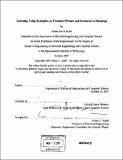Learning, using examples, to translate phrases and sentences to meanings
Author(s)
Kraft, Adam Davis
DownloadFull printable version (31.35Mb)
Other Contributors
Massachusetts Institute of Technology. Dept. of Electrical Engineering and Computer Science.
Advisor
Patrick Henry Winston.
Terms of use
Metadata
Show full item recordAbstract
Before we can create intelligent systems that exhibit the versatility of the human intellect, we must understand how our command of language enables the uniquely broad scope of our reasoning ability. To pursue such an understanding, we must discover the ways by which language gives rise to representations which, in turn, serve as the building blocks of models that capture constraints and regularities of our environment. The work described in this thesis constitutes a step toward this goal. I have combined aspects of Winston's Arch learning methodology with implementations of three powerful representations: Lexical Conceptual Semantics[Jackendoff 1983], Transition Spaces[Borchardt 1993], and Thread Memory[Vaina, Greenblatt 1979], in a system that learns to instantiate semantic descriptions from language based on a sequence of examples. My program, Lance, builds models of the correspondences between parse trees and semantic descriptions by generalizing from a sequence of pairs of sentence fragments and descriptions. Additionally, counterexamples of one type of correspondence model may be generated from examples of similar models in order to facilitate learning by near miss. The result is that my system can learn such constraints as in order for a sentence to convey a transition, it must contain a verb that means either "change," "appear, " or "disappear." (cont.) In this work I developed an approach based on presentation of parse trees paired with instantiated representations and the Arch-Learning paradigm, and implemented Lance, a 12,000 line Java program. I demonstrated that from a training sequence of 95 examples, Lance learned 27 models of THINGS PARTS, PLACES, PATHELEMENTS, TRAJECTORY-SPACES, TRANSITION-SPACES, CAUSES, and IS-A relations.
Description
Thesis (M. Eng.)--Massachusetts Institute of Technology, Dept. of Electrical Engineering and Computer Science, February 2008. Includes bibliographical references (p. 90-91).
Date issued
2008Department
Massachusetts Institute of Technology. Department of Electrical Engineering and Computer SciencePublisher
Massachusetts Institute of Technology
Keywords
Electrical Engineering and Computer Science.